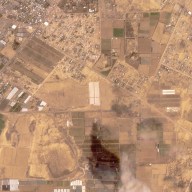HALIFAX, N.S. – Parts of Atlantic Canada can expect heavy rain and hurricane-force winds topping 120 kilometres per hour by late Sunday as hurricane Bill transforms into a large but still-powerful tropical storm, the Canadian Hurricane Centre says.
According to the latest forecasts, Bill will likely lose its status as a hurricane Sunday morning as its eye tracks south of Yarmouth, N.S., but it will nonetheless bring severe weather to the region later in the day.
“We are expecting that when it arrives, it will still be carrying hurricane-force winds just because it’s so strong right now, and it’s going to take a while for those winds to drop,” Peter Bowyer, the centre’s program supervisor, said in an interview Thursday.
“Our water temperatures out there are not really cool enough to bring those winds down as quickly as we would like.”
Bowyer said the water along the edge of the continental shelf is 20 Celsius, which is warm for this time of year. But tropical storms need water temperatures of at least 26 C to draw energy and grow stronger.
Still, the fact that the ocean temperature is slightly warmer than average means Bill will maintain much of its strength.
“What it means is that the waters aren’t cool enough to really knock the stuffings out of it as quickly as we would like to see,” Bowyer said.
The projected track of the eye of the storm, which is subject to change in the days ahead, currently takes Bill within 150 km south of Halifax and over the southern edge of Cape Breton before moving on to Newfoundland early Monday.
Environment Canada has yet to issue any warnings because the storm is still too far away, having yet to reach Bermuda.
“It’s too early to be yelling, ‘Batten down the hatches!”‘ said Bowyer. “But it’s not too early for everybody to get ready. We have a storm heading in our direction. We have a few days’ grace before it gets here.”
The latest computer models suggest Bill’s track could reach as far west as the Bay of Fundy, or it could head east and remain farther offshore.
If Bill moves toward the westward edge of its projected path, much of Nova Scotia could find itself on the eastern side of the storm, where the most powerful winds are produced.
However, the storm is so large that Bill will have an impact on Atlantic Canada no matter where it heads, Boyer said, noting that the eye of the storm spanned 50 km on Thursday.
By Sunday, when Bill enters Canadian waters, the storm is expected to spread out, producing gale-force winds extending 370 km from the eye.
Winds that reach more than 60 km/h are described as gales. Storm-force winds top 90 km/h.
Rainfall amounts could reach up to 100 millimetres, which is roughly the amount that Halifax gets in an average summer month.
Bowyer said mariners are being warned that Bill will be bringing gales to the region’s southern waters within the next 72 hours.
“We’re telling them this is a good time to start thinking about getting out of there,” he said, noting it can take up to three days for offshore vessels to make it to a safe port.
The Category 3 storm was still well south of Bermuda by Thursday afternoon, producing maximum sustained winds at 190 km/h.
Bermuda was under a hurricane watch, but the storm is expected to pass between the island and the U.S. eastern coast on Saturday.
As of Thursday afternoon, Bill was moving northwest at 29 km/h, a fairly quick pace for a hurricane.
Forecasters at the National Hurricane Center in Miami say Bill could strengthen and become a Category 4 storm again on Friday.
















